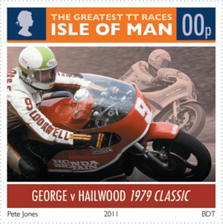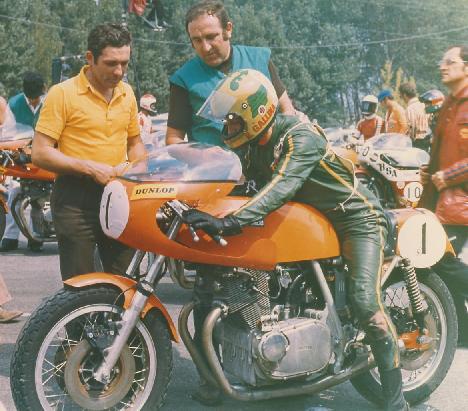The golden years
The Honda race history
For most people, the Honda race history starts with
the 1959 entry of the Honda team in the Isle of Man TT. However, although
practically unknown in Europe at the time, Japan in those days had a fast growing
motorcycle industry, but their models looked very old fashioned, and the ones that
did look (more or less) modern were often straight copies
of German, British or American motorcycles.
Honda, even in those days already a very big motorcycle manufacturer, faced
the problem that it would be very difficult to sell its bikes worldwide.
Japanese products in general had a bad reputation regarding quality, based
on Japanese pre-war products . So how do you overcome such a problem?
By proving to the world, that your engineering and the resulting products
are superior -in the case of motorcycles by winning Grand Prix with them
Soichiro Honda had decided, in the beginning of the fifties, that
one day he would compete in the famous TT of Man, and in 1954 a 220cc
single cylinder prototype racer was developed
In that same year, Soichiro took a trip to Europe, watched the TT, and was very disappointed: the then European 250cc racing bikes had on average more than double the power of his prototype. He also used his trip to go on a buying spree; he bought rev counters, carburettors, rims, spark plugs and what have you. The story goes that, upon arrival at the airport for his return flight to Japan, his luggage was overweight and he was not allowed to check in. Honda opened his suitcases, took out all his clothing, put on as much as possible on top of each other, filled his pockets with parts, and that did the trick, whereupon he remarked to the airport personnel: "You are idiots! Now I'm allowed in, but the total weight in the plane is exactly the same!" He was quite right, of course; they should set a limit to the weight of passengers together with their luggage, not to luggage alone.
A couple of years later, Honda had developed 250 and 305cc twins with a single OHC, used in national events
By 1959, Honda decided he was ready to take on the rest of the world, and the first Japanese team arrived on the Isle of Man.
Pre-1959 events
Soichiro Honda at the Asama camp during the second Asama Kazan race
![Image]()
The second Asama Kazan race (250cc class)
![Image]()
The Honda race history
For most people, the Honda race history starts with
the 1959 entry of the Honda team in the Isle of Man TT. However, although
practically unknown in Europe at the time, Japan in those days had a fast growing
motorcycle industry, but their models looked very old fashioned, and the ones that
did look (more or less) modern were often straight copies
of German, British or American motorcycles.
Honda, even in those days already a very big motorcycle manufacturer, faced
the problem that it would be very difficult to sell its bikes worldwide.
Japanese products in general had a bad reputation regarding quality, based
on Japanese pre-war products . So how do you overcome such a problem?
By proving to the world, that your engineering and the resulting products
are superior -in the case of motorcycles by winning Grand Prix with them
Soichiro Honda had decided, in the beginning of the fifties, that
one day he would compete in the famous TT of Man, and in 1954 a 220cc
single cylinder prototype racer was developed
In that same year, Soichiro took a trip to Europe, watched the TT, and was very disappointed: the then European 250cc racing bikes had on average more than double the power of his prototype. He also used his trip to go on a buying spree; he bought rev counters, carburettors, rims, spark plugs and what have you. The story goes that, upon arrival at the airport for his return flight to Japan, his luggage was overweight and he was not allowed to check in. Honda opened his suitcases, took out all his clothing, put on as much as possible on top of each other, filled his pockets with parts, and that did the trick, whereupon he remarked to the airport personnel: "You are idiots! Now I'm allowed in, but the total weight in the plane is exactly the same!" He was quite right, of course; they should set a limit to the weight of passengers together with their luggage, not to luggage alone.
A couple of years later, Honda had developed 250 and 305cc twins with a single OHC, used in national events
By 1959, Honda decided he was ready to take on the rest of the world, and the first Japanese team arrived on the Isle of Man.
Pre-1959 events
Soichiro Honda at the Asama camp during the second Asama Kazan race

The second Asama Kazan race (250cc class)

















































































































































